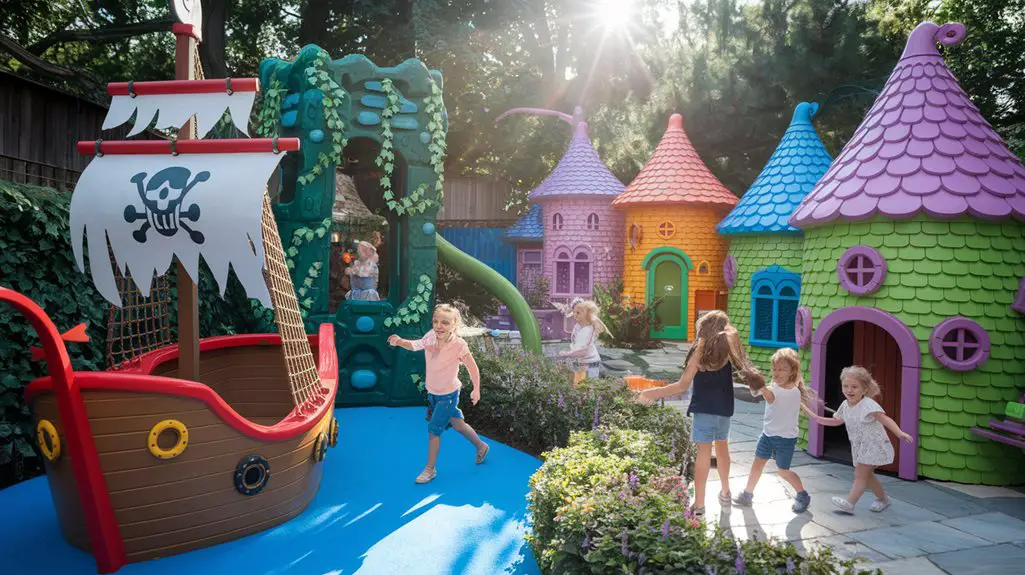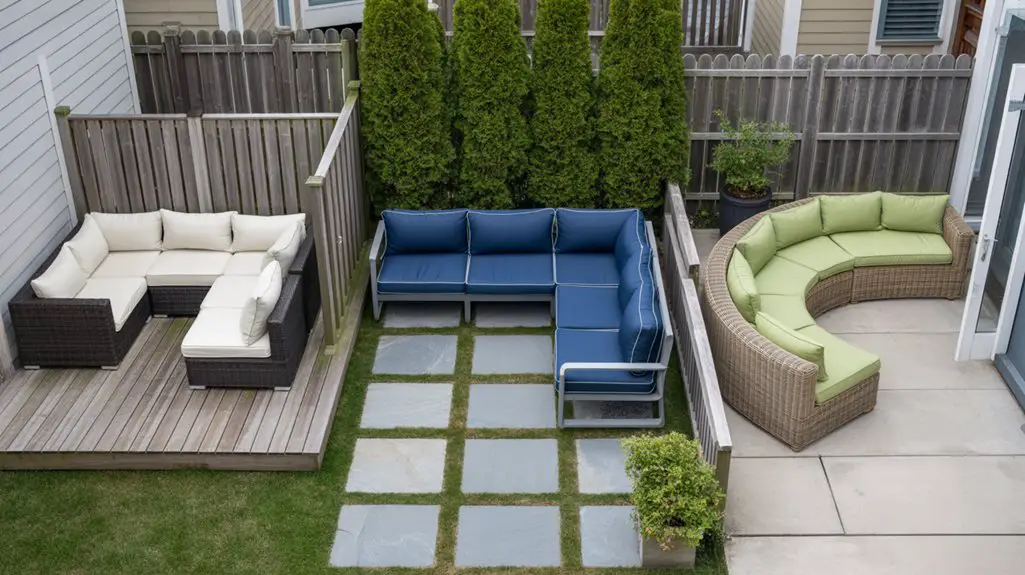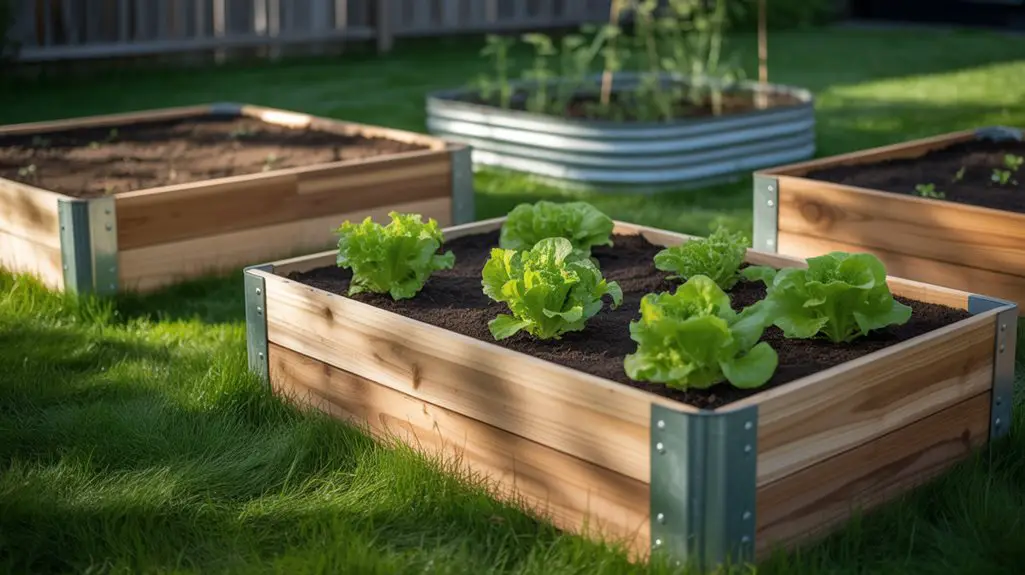You’ve probably noticed that children gravitate toward themed spaces, where imagination flourishes beyond ordinary playtime. When you transform your backyard into a dedicated play area with intentional zones, you’re not just creating entertainment—you’re cultivating experiential learning environments that connect kids to nature. Strategic placement of native plants around dinosaur excavation sites or beneath pirate ship masts adds dimension while supporting local ecosystems. These thoughtfully designed outdoor worlds don’t require excessive plastic or environmental compromise. What might your yard become?
Pirate Ship Adventure Playground
When planning a pirate ship adventure playground, you’ll want to position it strategically within your yard’s existing landscape. Utilize natural contours—placing the ship’s bow on elevated ground creates authenticity while minimizing excavation. Incorporate existing trees as integrated masts or crow’s nests to preserve mature vegetation.
Choose sustainable materials like reclaimed wood for your ship’s structure. Cedar and redwood offer natural resistance to decay without chemical treatments. Install permeable surfaces below for proper drainage and reduced runoff.
Surround your ship with native coastal grasses that sway like ocean waves. Plant resilient ground covers between stepping stones that form a “plank” pathway.
Consider drought-tolerant succulents as treasure-marking plants that require minimal maintenance. This approach creates an immersive play experience while maintaining ecological balance in your backyard ecosystem. Additionally, including pet-friendly landscaping options ensures that your backyard remains safe and enjoyable for all family members, including furry ones.
Enchanted Fairy Garden Retreat
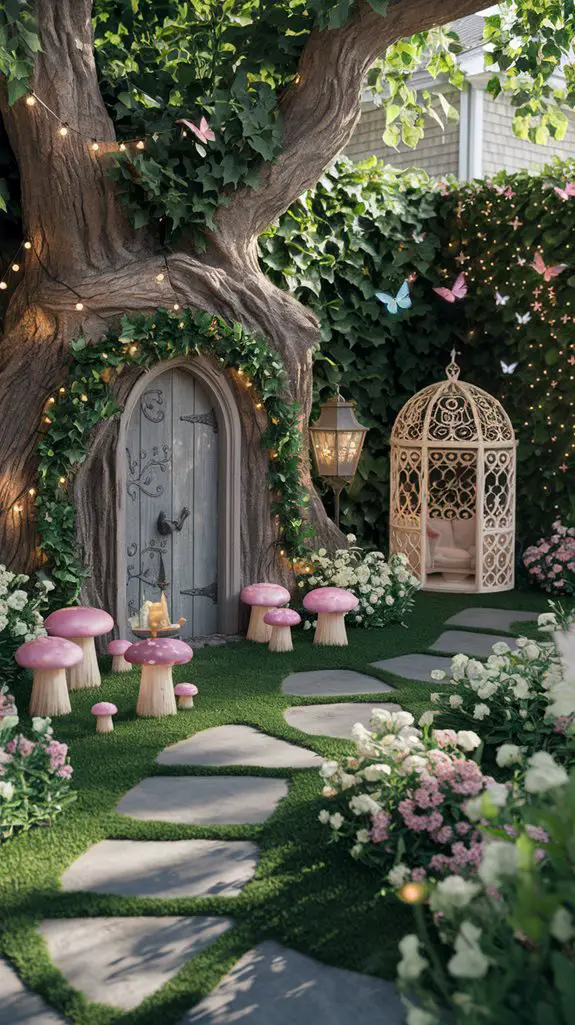
Creating a magical fairy garden retreat begins with identifying a secluded nook beneath existing shrubs or trees that provides dappled sunlight and natural protection.
Position miniature doors against tree trunks and arrange tiny houses crafted from natural materials like bark, stones, and moss on the ground below.
Plant low-growing herbs such as thyme, chamomile, and mint that children can tend while attracting beneficial insects. Incorporate native wildflowers to support local pollinators and establish sustainable ecosystems.
Add child-sized seating using tree stumps or smooth river rocks placed strategically throughout the space.
Define pathways with pebbles, mulch, or stepping stones that guide little feet through the garden while protecting delicate plants.
Complete the retreat with a small water feature—perhaps a glazed pottery bowl—where fairies can “bathe” and birds can drink.
Dinosaur Dig and Discovery Zone
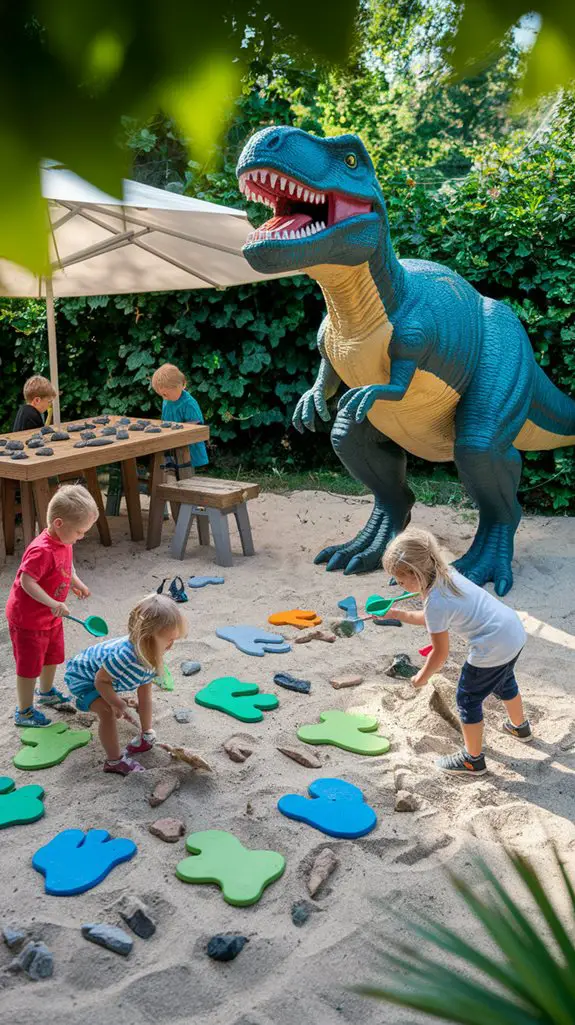
Transform an underutilized corner of your yard into a prehistoric adventure zone where budding paleontologists can unearth hidden treasures. Position large rocks and native grasses strategically to recreate a Jurassic landscape while maintaining natural drainage patterns.
| Materials | Eco-Friendly Options |
|---|---|
| Dig Pit | Coir or pine mulch |
| Fossils | Homemade plaster casts |
| Tools | Bamboo or wooden tools |
| Plants | Ferns and cycads |
| Shelter | Reclaimed wood canopy |
Create a circular dig area with permeable boundaries to prevent soil migration while allowing earthworms passage. Surround with drought-tolerant horsetail ferns and dwarf cycads—living fossils that connect children to prehistoric times. Install a small rainwater collection system nearby to supply water for mud excavations, teaching conservation while encouraging sensory play. This hands-on experience can spark an interest in environmental stewardship, fostering a sense of responsibility towards nature.
Outdoor Art Studio and Creativity Corner
Nature inspires creativity, which makes an outdoor art studio the perfect addition to your child’s play landscape. Position your studio beneath a shady tree where dappled light creates ever-changing patterns.
Use reclaimed wooden pallets to craft easels that blend with the environment, and repurpose old kitchen containers for storing natural materials. Encourage your children to collect fallen leaves, pinecones, and petals as artistic elements.
Install a rain-collection barrel with a spigot for cleaning brushes, teaching water conservation while supporting creative flow. Plant marigolds and sunflowers nearby—their vibrant colors stimulate imagination while their petals can become art materials. Incorporating nature-inspired art can further enhance the beauty and tranquility of the space.
When designing the space, leave open sightlines so you’ll observe your young artists while they’re immersed in creating. This thoughtful arrangement nurtures both independence and connection to the living world around them.
Miniature Sports Arena for Active Play
Active children thrive in dedicated movement spaces where they can develop coordination while burning endless energy. Transform a corner of your yard into a compact sports zone using natural boundaries of native shrubs as court markers.
You’ll find bamboo makes excellent goal posts, while fallen logs create perfect balance beams. Install a small basketball hoop on an existing tree rather than concrete, preventing unnecessary soil compaction.
Designate running paths with pebble borders that double as drainage systems during rainfall. Consider a grassy putting green that needs minimal water yet provides hours of focused play.
Position your sports area to maximize shade from existing trees, reducing heat exposure while encouraging play throughout the day. This thoughtful placement protects both plants and children in your ecosystem-friendly active space. Additionally, incorporating backyard play area landscaping tips can enhance the overall design and functionality of your sports zone.
Secret Jungle Explorer’s Hideaway
Beyond athletic play zones, children’s imaginations flourish in wild, plant-rich environments that spark adventure. Transform a corner of your yard into a jungle explorer’s hideaway by layering native plants of varying heights to create secret pathways and hidden nooks.
Position climbing vines on trellises to form natural walls, while drought-resistant ferns create lush undergrowth. Install a small wooden platform elevated among dense foliage where kids can observe wildlife undetected.
Add weatherproof storage crates containing magnifying glasses, field guides, and sketch pads for documenting discoveries. Integrate a rain barrel system that children can operate to water their jungle, teaching water conservation principles. Additionally, incorporating wildlife-friendly water features can enhance the habitat, attracting more creatures for children to observe and learn about.
Choose non-invasive, pollinator-friendly plants that serve dual purposes—creating mystery while supporting local ecosystems. This multisensory space encourages stewardship as children navigate their secret domain.
Space Mission Command Center
While earthbound gardens meet many play needs, a dedicated space mission command center launches children’s imaginations into the cosmos.
Position your command module in a circular clearing with native grasses forming a natural landing zone perimeter. Install a repurposed satellite dish or create one from sustainable bamboo to establish communication with distant planets.
Arrange weather-resistant control panels on recycled wooden crates, using solar-powered LED lights for authentic mission ambiance. Plant star-shaped flowers like asters and daisies around the perimeter, creating a galaxy effect.
Add a telescope station beneath a shade sail for daytime star “searching.” Incorporating elements of wildlife habitat design can enhance the overall experience by teaching children about the importance of biodiversity.
You’ll foster both astronomical curiosity and environmental stewardship as children navigate between worlds. The contrast between terrestrial plant life and imagined celestial bodies creates a perfect learning environment where space exploration and ecological awareness orbit together.
Farm-to-Table Garden and Market Playhouse
A thriving farm-to-table garden playhouse connects children directly to food systems while creating endless opportunities for imaginative play.
Position raised beds at child height around a charming wooden market stand where kids can “sell” their freshly harvested produce.
Include a rainwater collection barrel that demonstrates sustainability while providing water for thirsty plants.
Dedicate separate zones for vegetables, herbs, and flowers to teach spatial organization and companion planting.
Choose fast-growing varieties like radishes and lettuce for quick rewards that maintain young gardeners’ interest. Fast-growing vegetables like these are great choices for beginners.
Add child-sized tools, watering cans, and baskets that fit small hands perfectly.
The market stand can feature a chalkboard for pricing, play money, and produce bins that transform garden harvests into entrepreneurial adventures.
This multi-sensory space nurtures environmental stewardship while developing fine motor skills.
Conclusion
As you carefully craft each engaging play space, you’re not just building playgrounds—you’re growing your child’s world. Position natural elements strategically, leaving room for wonder to unfurl between recycled materials and native plants. What’ll happen when they discover the hidden path behind the rain barrel? Or the butterfly that lands on their sustainably-sourced fort? You’re planting seeds of imagination that’ll bloom for years in your thoughtfully designed, earth-friendly haven.

